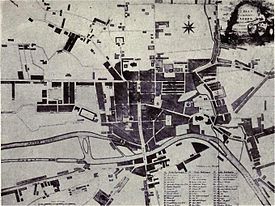History of Leeds
The town had become part of the Duchy of Lancaster and reverted to the crown in the medieval period, so was a Royalist stronghold at the start of the English Civil War.The ancient estate straddled the wapentakes of Morley[10] and Skyrack,[11] encompassing Leeds, Headingley, Allerton, Gipton, Bramley, Armley, Farnley, Beeston and Ristone (Wortley).[4] That Leeds was owned by one of the chief favourites of William was fortunate; the probability is that the lands of the de Lacy ownership were spared when the harrying of the North took place.While the greater part of the county was absolutely destitute of human life, and all the land northward lay blackened, Leeds in 1086 had a population of at least two hundred people.In 1399, according to the Hardynge Chronicle, the captive Richard II was briefly imprisoned at Leeds, before being transported to another de Lacy property at Pontefract, where he was later executed.[12] The new town was laid out along the line of a street, later to be called Briggate, which was wide enough to hold a market, with about thirty burgage plots on either side.Tax returns of 1334 and 1377 show that population of the whole parish before the Black Death was about 1,000 people of whom 350 to 400 lived in the central area including the borough.The township was concerned with little more than agriculture, and such trade as it knew was confined to those retailings which establish themselves wherever communities spring up—dealings in the necessities of life, which, reduced to a minimum, are merely food and clothing.The town itself was small—it was probably confined within a triangle formed on the lines of the present lower Briggate, Kirkgate, and the River Aire, with the parish church at one angle somewhere about, perhaps on, the site of the modern one.By 1536, when John Leland visited it, he was able to report of it that it was a pretty market town which stood most by clothing and was as large as Bradford, though not so "quik", by which he evidently meant not so enterprising.Here is the origin of Leeds Grammar School which, first housed in the Calls, and subsequently—through the beneficence of John Harrison—in Lady Lane, had by the end of that century become an institution of vast importance.The charter, premising that Leeds in the County of York is an ancient and populous town, whose inhabitants are well acquainted with the Art and Mystery of making Woollen Cloths, sets up a governing body of one Alderman, nine Burgesses, and twenty Assistants.But the privilege for some years was a limited one: the Crown reserved to itself the rights of appointment to any of the thirty vacancies which might occur by death: popular election did not come for some time.[4] Eighteen years after the granting of the charter of incorporation, Leeds joined with other towns in the neighbourhood in a Memorial to the King wherein he was besought to settle his differences with the rebellious Parliament.Against him on Monday, January 23, advanced the redoubtable Sir Thomas Fairfax, at the head of a Parliamentary force which appears to have numbered at least 3000 horse and foot.Savile returned the answer which was doubtless expected, and in the teeth of a heavy snowstorm, Fairfax led his troops forward to the assault.It rapidly went in favour of the assailants, and by four o'clock the Parliamentarian leaders and their troops were in Briggate and Boar Lane, while Savile and others were fleeing for their lives.After his surrender to the Scottish generals at Kelham, near Newark, he was led northward to Newcastle; on his return from that city, he spent one night in the house called Red Hall, in Upper Head Row.It set up a Mayor, twelve Aldermen, twenty-four Assistants or Councillors, a Town Clerk, and a Recorder; it also provided for local election to vacancies.[14] During the Middle Ages, Cistercian monks, such as those at Kirkstall, were involved in sheep farming, and weaving was introduced to West Yorkshire during the reign of Edward III.By the early 18th century, cloth trading had outstripped the capacity of the bridge, and had moved to trestle tables in up to two rows on each side of Briggate.Daniel Defoe (c. 1720) mentions that Leeds traders also travelled all over the country, selling cloth on credit terms; and that an export trade existed.Armley, Bramley and Kirkstall became milling centres and areas such as Roundhay became middle class suburbs, the building of the Leeds Tramway allowing them better connections with the rest of the city.[example needed] Barnbow in Cross Gates was a large ammunitions factory producing ten thousand shells per week by August 1915.Mechanic Mr William Parking was presented with an engraved silver watch for his bravery in saving factory workers during the incident.[18] This was a parliamentary committee which was established in 1918 by the Ministry of Reconstruction in order discover what a woman's view on post-war housing would look life.Flaxton Terrace was the only street to be damaged during the night-time blackout air raid, with nearly all the other bombs landing on Cross Flatts Park.









Leeds, KentBrian LeedsJ. M. W. TurnerBeeston HillMarshall's MillLeeds MinsterYorkshireCelticNorman conquest of EnglandIlbert de LacymedievalDuchy of LancasterRoyalistEnglish Civil WarIndustrial Revolutionpost industrialindustrialHistoria ecclesiasticaEdwin of NorthumbriaDomesday BookJohn CossinsBrittonicRiver AireLoinerLeeds City CouncilOld EnglishBritishAnglo-SaxonBronze AgeWoodhouse MoorBrigantesAlwoodleyHeadingleyBeckett's ParkCambodunumCamelotWayland the SmithWest Yorkshire HoardShire OakwapentakeSkyrackBramleyRodleyFarnleyArmleyWortleyFarsleywapentakesAllertonGiptonBeestonEdward the ConfessorWilliam the ConquerorHonourLincolnshireLancashirePontefract Castleharrying of the NorthRichard IICistercianKirkstallKirkstall AbbeysubinfeudatedRalph PaynelcharterPoll Tax of 1379SnaithTickhillbattle of LincolnRanulf, Earl of ChesterHenry IVthe CrownBriggatemodern oneTudor periodRothwellmarket townJohn LelandBradfordLeeds Grammar SchoolJohn HarrisonCharles ISir William SavilebreastworksSir Thomas FairfaxPuritanepidemicplagueKelhamNewarkNewcastleMaltonBeverleyNorthallertonAdam Baynesthe RestorationReform Act 1832Charles IIRalph ThoresbyHumberestuaryweavingEdward IIImanufactured in individual homesworstedfulling millWakefieldDaniel DefoeGeneral Post OfficeMetropole HotelYorkshire Trades UnionNational Union of Dyers, Bleachers and Textile WorkersLeeds TramwayHarehillsLeeds city centreAire & Calder NavigationLeeds and Liverpool CanalLeeds and Selby RailwayMarsh LaneLeeds Wellington stationCentralNew stationSheffieldDewsburyDurhamNorthumberland